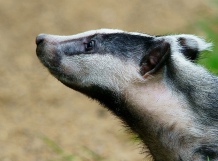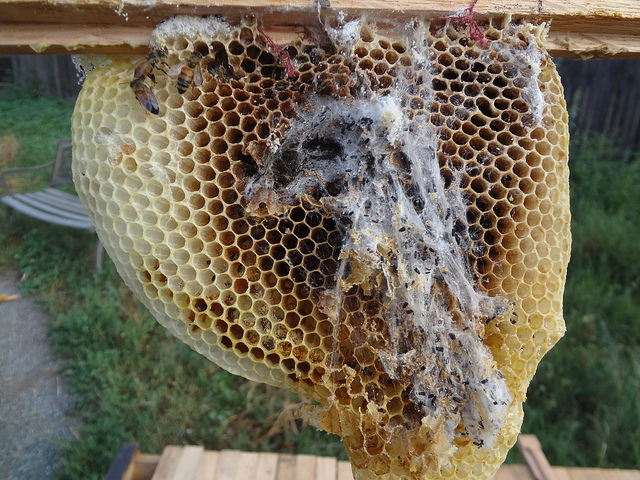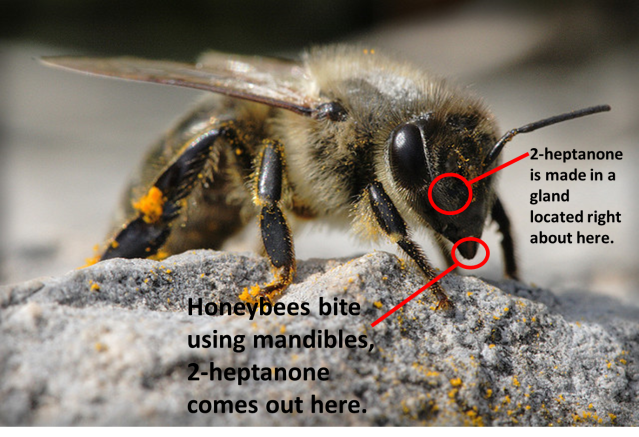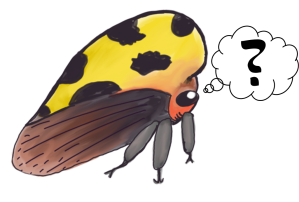 Today’s question comes to us from a friend of mine, through a conversation on FB instant messenger.
Today’s question comes to us from a friend of mine, through a conversation on FB instant messenger.
Wasps are a huge group, and at least 150,000 types of bees, wasps and ants have been described by scientists. Despite the fact most associate the term ‘wasp’ with ‘painful sting’, the number of species that can actually sting humans is pretty small compared to the rest of the order. In fact, a lot of these insects have actually lost their stingers.
The group most people think of when they talk about wasps, the Aculeates, are actually about 30% of the total wasp diversity. The vast majority of species are either incapable of actually stinging people, or just not encountered by people (other than entomologists) to where a sting is really an issue.
So I’m going to pick a group I’m familiar with-the paper wasp genus Polistes-because it’s the stinging wasp that’s most commonly encountered by people. I’m also going to be discussing honeybees, since this is the group of Hymenopterans which most frequently stings people.
So today’s post is going to be about spitting, stinging and biting.
You know…all the fun things wasps do!
Wasps…bite? Doesn’t a stinger take care of the whole defense thing?
The stinger is a great tool, but it’s hardly a one size fits all solution. It evolved as an egg laying device, became modified to introduce host-controlling substances in some wasps, and then switched to a defensive role in a specific group of wasps that also includes ants and bees.

Contrary to popular belief, honey badgers care deeply about a lot of things.
Picture credit: Peter Trimming, via Flikr
License info: CC BY 2.0
The stinger is an imperfect design, because not all enemies can-or even should be-be stung. If you’re a honeybee or yellowjacket, you only get to sting once…and you can’t waste that opportunity on something minor like a Varroa mite. You have to save that for a honey badger…or even a bear!
While stinging, some bees and wasps need a way to steady themselves to get some leverage. It takes a lot of effort to stab something with your butt, and sinking your jaws into your enemy is a good way to get leverage. It also keeps your enemy from brushing you off while you make them miserable. It’s why most ants bite while they sting.
The most common reason these insects bite things, though, is to fight off tiny invaders. Most of the enemies bees, wasps, and ants deal with are actually much smaller than themselves. Bees get a lot of tiny parasites, things like waxworms and Varroa mites, which are too small and tough to sting.

Wax moths are caterpillars which burrow through wax frames, and eat the cocoons bees leave behind when they emerge. Bees don’t like them because they destroy their house as they eat, as seen in this picture.
Picture credit: di.wineanddine, via Flikr
License info: CC-BY-NC-SA-2.0
Paper wasps deal with similar parasite issues, and the most important population regulator of the invasive Polistes dominula is actually a small moth called Chacoela. These moths burrow through the nests, and eat the wasp larvae. Paper wasps have trouble detecting them for reasons scientists still don’t understand, but when they do find them…they use their jaws to take them out of the nest.
So what about defensive saliva? Is that a thing?
I know of one case where hymenopteran venom might come from the head, but it isn’t saliva per se.

A diagram showing where 2-heptanone is produced and excreted by the honeybee. Whether this compound is a venom, or some sort of alarm pheromone, is not entirely clear.
Picture credit:
Stavros Markopoulos
License info: CC-BY-ND-NC-2.0
Honeybees may have venom glands in their mandibles similar to how snakes have venom glands in their head. I say they might have that, because I’m not entirely sold on the evidence…but I do think the possibility is interesting enough to address in this post.
Honeybee behavior is driven by pheromones secreted by the queen, workers and larvae. It’s an extremely complicated system with a lot of parts, and one of those parts was thought to be a chemical called 2-heptanone.
2-heptanone is released when there’s a threat to the colony, but nobody knew what it was for. It was thought to be an alarm pheromone, but it didn’t cause bees to attack things like other alarm pheromones. Really high levels acted as a repellent, so it was thought that it might be a ‘stay away’ signal for younger workers or foraging bees for use during attacks. It was also thought it might be used to mark depleted flowers.The problem with this was that the concentration needed to repel the bees seemed really high, too high for the amount that bees had in reserve.
So a group of researchers, cited in the PLOS ONE article below, noticed that mites and caterpillars stopped moving when they were bit by the bees while the bees were removing these pests from the colony. They analyzed the bitten parasites, and found that 2-heptanone was found inside the insects which were bitten by bees. 2-heptanone was absent from insects which had recovered from the bites, or which had never been bitten.
So they hypothesized that bees inject 2-heptanone as venom while defending their nests from small invaders, and insects which have been injected with this chemical do become paralyzed for a very long time. So this is a good hypothesis, but as I said…I’m still skeptical.
The amount of 2-heptanone, the supposed bee head venom, they injected into wax moths was 250 times the amount which was found in the insects which had been bitten. While this caused the insects to stop moving for a really long time, it is still a lot higher than what’s injected during a bite. So it’s not really a great test of the hypothesis.
So does that mean they have venom glands in their jaws? Or is the research bunk?
I’m not sure because 250 times a natural dose is a lot. It’s hard to draw conclusions from their experiments because such a high dose was used. There’s also some questions about why this compound only appears in foraging bees, and why it’s production declines in guards. It’s not produced by the nurse bees, and these do most of the cleaning. I think they’re onto something, but the evidence is weak. There’s a lot of things which don’t make sense, and a lot of questions need to be answered before I’d say that this is true.
Despite these questions, I still think it’s an interesting hypothesis. I’d really like to see followup literature which addresses the problems in the research. I wouldn’t say that honeybees have a venomous bite, but I don’t think it’s entirely impossible either.
So that’s honey bees. What about wasps?
Most of the research that’s been done on wasp spit has been done on the larvae of Polistes paper wasps. The larvae of Polistes paper wasps produce a nutrient rich saliva that has a lot of sugars and amino acids. It was previously assumed that Polistes larvae used their saliva as a reward for care by the worker wasps, but recent research has cast doubt on this idea because the adults don’t appear to consume the saliva.
So as of some fairly recent research, our understanding of paper wasp larval saliva is back at square one. We have no idea what it’s actually used for.
The adult saliva is likely very different from the larval saliva because the adults use their saliva for a lot of different purposes. It’s used for digestion (Nancy discussed bug spit awhile back), but it’s also used for building. Paper wasp adults use their saliva to build the nest, by mixing it with wood pulp. So it has adhesive, and probably antimicrobial properties as well.It doesn’t appear to be active in defense, but wasps just haven’t been studied all that much.
The Bottom Line
I see no reason to think the saliva of adult wasps has any defensive value. Paper wasps are pretty tough predators, even though they look really delicate, and they appear to use brute force while hunting. From what I’ve seen watching them hunt, there’s no need for them to use venom.
Venom from the head region of honeybees isn’t out of the realm of possibility, but I’d like to see evidence that’s a lot stronger before I support the idea uncritically. Regardless, bees and paper wasps are different…and what happens in one group might not happen in the other.
Some sort of defensive compound in the spit isn’t impossible, but I find it really unlikely that wasps inject any sort of venom into people when biting them.
Works Cited
Suryanarayanan, Sainath, and Robert L. Jeanne. “Antennal drumming, trophallaxis, and colony development in the social wasp Polistes fuscatus (Hymenoptera: Vespidae).” Ethology 114.12 (2008): 1201-1209.


Very informative, yet again. Love your posts and they show the complexity of trying to understand how nature works. Great stuff!
LikeLike
Thanks for the compliment, and it means a lot.
Science can be a difficult, tricky process. It’s really important to look at the data behind some of this stuff, and the methods people use to figure this stuff out.
So when I write about an experiment, I always try to go out of the way to point out why I believe the data instead of saying ‘well, this is just true’. I can’t do that with every post, but I believe that sort of thing is the most important part of science writing.
LikeLike
I was certainly bitten by a paper wasp when I was a child – I was hanging on to the edge of an above ground pool, and a nest was there under the overhang. I felt a very sharp pinch, but no burning sensation afterward, so knew I had not been stung. I’m not sure why the wasp made that choice, but I’m somewhat grateful that it did. lol
LikeLike
Paper wasps tend not to sting, for reasons I don’t quite understand.
They’re primitively social, with a structure that’s mostly based on bullying. Frankly, they barely stay together and don’t have the sort of camaraderie which some of the other bees and Vespids have.
I’ve ran into paper wasp nests before, and I’ve had them land on me right between the eyes. They didn’t sting me, they just landed there and hung out for an uncomfortably long couple of seconds.
Paper wasps have…weird personalities.
LikeLike
I just love how hose who are into a small section of earth’s diversity are actually quite smitten. They are totally in love with their creatures -or plants. How many people in this world are even aware that wasps might have personalities?
I have had a wasp on some part of me for an uncomfortably long time, and they have just been chewing away, tasting to see what I had to offer. Luckily they did not sting because I react quite badly to bees and wasps – not emergency room stuff, but a couple of weeks of swelling and intense itching.
LikeLike
I’m supposed to be allergic to wasps and bees,something got me today and the emt and doctor didn’t see a stinger,but I felt something on my shoulder blade that sent me across the room,the fire department killed a wasp, so,do wasps bite?
LikeLike
I have been bitten by yellow jackets. It was clearly a bite, not a sting. It hurt like hell.
LikeLike
Wasps can alternatively bite instead of stinging on occasion, but queens and workers sting most frequently. Male wasps can only bite as their sole form of self defense, much like a carpenter ant with a possible painful pinch from their mouth.
LikeLike